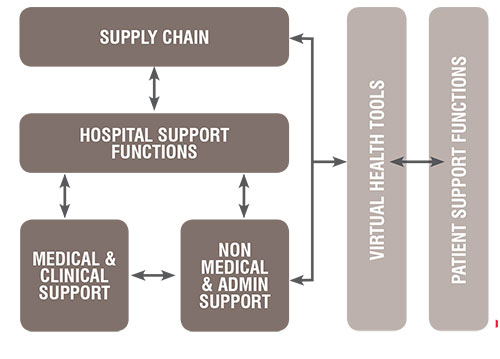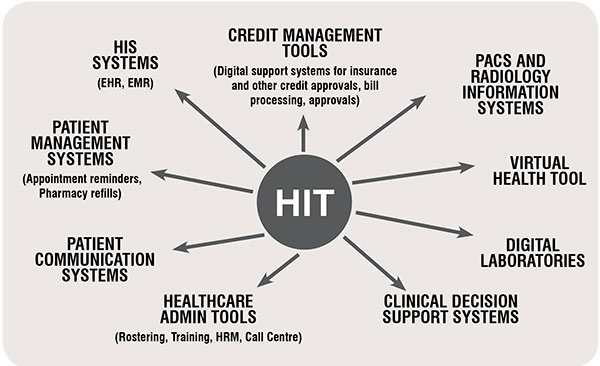
The new normal will also impact how we chose to consume healthcare services. The new realities around this pandemic and the threat of more such, should also make us sit up and reflect on wellness and good health along side a good curative system.
I woke up burning with fever. There was no one home to drive me to a doctor. I could not have risked asking my elderly parents or my young child to take me to the clinic or hospital during this time. They are at vulnerable ages for this new virus. I looked up the doctor chat option of my health insurance. They gave me a number to connect to a hospital remotely. I dialled in and booked my appointment. I could have used my phone however I chose my computer to log in with the doctor for a call. I did have a basic kit – thermometer, BP monitor, oximeter at home. These helped. I quickly measured these, downloaded the hospital app and uploaded these details so my doctor could record these. She came online, the video chat was very helpful. I told her about the symptoms. She could look at my eyes and throat as well. Checked a rash as well. Hopefully this is a regular flu. She sent me the e-prescription via the app and the email as well. On my app popped up a message from the pharmacy. I quickly requested a delivery for the prescribed medications as well as some OTC items. I got the medication in two hours. Am feeling better as the meds kick in. In case they don’t, my doctor has requested for some blood tests which I will schedule through the app. And if I need more care, I can opt for a home care package where I will be assigned a nurse who will connect with me daily and get my doctor to look me up when needed. Gosh, am I thankful for this service!
The pandemic has exposed the virtuality of our lives and yet it is the virtual that has come to our rescue at this time, especially for supporting our health and well being. The virtual healthcare systems we already find ourselves leaning on have indeed a lot more to offer.
These systems have at this critical time offered multiple solutions to common global challenges for providers and service users: healthcare access at home, overcoming scarcity of skill and talent across distance, saving time and administrative hassle at physical locations, information at finger tips, doctor on your phone, and remote monitoring and care. During the ongoing pandemic, and given the nature of the disease and its spread, virtual health has offered a safety bubble for those suffering from chronic diseases requiring ongoing care as well as those getting new infections and being able to do with remote care thus reducing the load on the already overloaded and COVID-19-ensnared healthcare systems.
The two key global issues that every healthcare system faces today are – availability of health services and the quality of care. Virtual systems can support both these requirements along with the support system of pharmacy and diagnostics at the doorstep.
In India, as also in many parts of Asia and Africa, the adoption of virtual healthcare through digital solutions has picked up rapidly in the last quarter. The pending policy decisions were speeded up to take the immediate advantages offered. Of course, there is a lot more to be done on this front to push towards building a homogeneous system—during the pandemic as well as well after.
Going forward, there are many opportunities lying dormant, both in terms of supporting a safe means of outreach to the patients, as well as overcoming resource snitches in semiurban, remote and rural areas. There is another advantage too. A good amount of cost savings can also be done by adopting the various offerings of virtual healthcare through digital solutions. And much more if we add the big data and AI possibilities.
In fact, apart from offering new features to add to the already existing service lines, virtual healthcare comes with a multitude of prospects. Each of these lines is already at work in their own niches and areas. The task ahead to make this successful is to integrate them. Those of us who have worked with various IT systems trying to digitise our work flows, know very well the nuances and the wide disparities which come to the fore while trying to integrate multiple systems for data flow. Today, ‘smooth’ is the much needed dictum whether in implementation or post-implementation working of these softwares. Apart from the code challenges, there is one more challenge that needs to be overcome: the available internet quality and bandwidth. This will eventually become a critical deciding factor for these systems as the usage expands to semi-urban, rural and remote areas. These virtual systems will need to rest on the underlying basic IT and telecom infrastructure to prove successful in the long-term.
And if virtual healthcare becomes a thriving reality, the future hospital experience could be a lot different as well. The non-critical medical services will move out of the hospital to a virtual and remote mode supported by mobile clinic services and small specialised setups. Home care services will also grow. All this will change the paradigm of how healthcare services will be provided and used. This could better the experience as well as reduce costs on huge infrastructures and maybe also make it more efficient. In addition, it will provide employment opportunities in the deeper etches of the state, thus de-congesting the overpacked urban areas. In yesteryears in India, the healthcare experience was of the doctor and/or the ’vaid’ coming home to see the patient in the comfort of his / her home and his / her room, surrounded by family members and loved ones. The doctor would interact with everyone and the respect for him in everyone’s eyes was supreme. Maybe this heralds a way back to the basics, albeit with more technology and support for the treatment now available to the healers through virtual tools.

Walking through the time zone here I share my future experience.
I am born in the comfort of my home, sealing an inexplicable mark of presence in the room that I was born. The special photographers invited for the occasion clicked me with my very new Mom & Dad, my doctor and my nurse and the souvenir hangs on the wall of my room alongside the clay imprints of my tiny hands and feet. My mother had chosen a water birth in a makeshift collapsible pool in my then to be room. The makeshift baby care area stood by as part of the sterile zone created for the birthing. Of course, the advanced life support ambulance had stood by in case she or me had to be run to the hospital for specialised care.
As I grew, I vaguely remember (imprinted memory from photographs) monthly visits from my nurse and paediatrician. In they came with their cute trolley with a volley of all the things they would require. These things would roll into my room and I would get only get more excited, at the prospect of exploring anything new that entered my room.
Through my slightly older years I remember fondly sitting on my grandparents lap as they perched in front of their computers for their monthly doctor consults. From time to time an ambulance rolled in front of the house where they went for their exams and diagnostics. And the medicines were delivered by kind sweet people who also sometimes brought me a lollypop.

Once I remember my grandma became really ill and she had to be taken to the hospital. This was a small emergency room like area; then she was shifted to the ICU. After 2 days she was back home with a nurse by her side for another two days to help her recuperate. A physiotherapist came by daily and gave her interesting exercises to do. These were fun exercises where you played games through AI. I won many times and these brought me brownie points with my parents as they earned loyalty points at the hospital.
Every year I see my parents fill up some forms on their phones. They sometimes ask me questions like … They also take my height and weight etc. They measure theirs too. They are filling the Health Risk Analysis. If any of the scores not ok here, I expect the health van to roll across to take some tests. My parents hate that because that means their mandatory insurance will take away some bonus points.
Health means wellness and so wealth! All of us are incentivised to keep well in many different ways by our insurance companies as well by way of tax relaxations